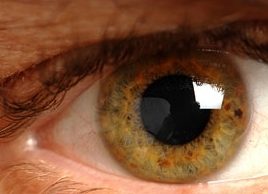Glaucoma
Glaucoma is the leading cause of preventable blindness in Canada.

Source: Adapted from Looking After Your Body: An Owner’s Guide to Successful Aging, Reader’s Digest
What is glaucoma?
Glaucoma occurs when high intraocular pressure (fluid pressure within the eyeball) cuts blood flow to your optic nerve, causing the nerve to deteriorate. Blind spots, blurry vision, poor peripheral vision, and, sometimes, headaches occur as the damage progresses.
Your eye has two fluid-filled chambers. The optic nerve is located in the retina behind the posterior (rear) chamber, which is filled with a jellylike fluid called vitreous humor. The anterior (front) chamber is filled with a fluid called aqueous humor. Normally, your eye continually produces aqueous humor and drains it away through an outlet, or angle, between the iris and cornea. But if you have glaucoma, the aqueous humor builds up within the anterior chamber, putting pressure on the posterior chamber and your optic nerve. The fluid buildup is caused either by too much fluid production or by inadequate fluid drainage.
As we age, we become more susceptible to two types of glaucoma:
- Open-angle glaucoma, which accounts for 90 percent of all cases of glaucoma, occurs when the drainage angle remains open, but excess fluid production causes increased pressure. It usually goes unnoticed because damage occurs so slowly.
- Closed-angle glaucoma occurs when the drainage angle becomes blocked, preventing sufficient fluid outflow. It may be gradual or sudden (acute glaucoma), with pain and vision loss. Sudden onset signals an emergency—the pressure must be released right away to prevent blindness.
Who is at risk for glaucoma?
Doctors don’t know exactly what causes glaucoma, but several factors put you at greater risk. You’re more likely to develop glaucoma if you:
- Are over age 40.
- Are of African descent.
- Have diabetes.
- Use corticosteroids.
- Have a family history of the disease.
- Are under stress.
- Have a blood vessel disease (which disrupts blood flow).
Treatment for glaucoma
Your ophthalmologist will measure your intraocular pressure with a tonometer, a small device that uses a jet of compressed air to press on the outside of your eyeball. The exam is painless and takes only a few seconds. Glaucoma is diagnosed when your intraocular pressure is above 21 mmHg. At the same time, your retina and optic nerve can be examined. A visual field test, which checks both your peripheral and central vision, may also be performed.
Glaucoma can’t be cured, but treatment can lower your intraocular pressure to prevent optic nerve damage. Prescription eyedrops either decrease the amount of aqueous humor produced or increase its outflow. The most commonly used drugs are the beta-blockers levobunolol (Betagan) and timolol (Timoptic). Sometimes dipivefrin (Propine) or pilocarpine (Isopto Carpine) are prescribed. Use these eyedrops every day and instill them properly.
If the medications don’t work and surgery is needed, a tiny hole is made in your iris to drain the fluid (iridectomy). Or a laser is used to punch tiny holes in the trabecular network, the drainage system near the angle (laser trabeculoplasty). For acute closed-angle glaucoma, emergency reduction of eyeball pressure is done either with surgery (iridectomy) or drugs.
Prevention of glaucoma
- Curb caffeine. Caffeine may contribute to excess fluid pressure in the eye. Avoid drinking more than two cups of coffee, four cups of tea, or four caffeinated soft drinks a day.
- Exert yourself. Aerobic and strength-training exercises can help decrease intraocular pressure. Some studies have found that people with glaucoma who exercise three times a week or more can lower their pressure by about 20 percent. But you’ll still need to take your glaucoma medications. Ask your doctor to recommend a long-term exercise plan that’s right for you.
- Schedule an exam. Untreated glaucoma leads to blindness. But because it takes years to happen, early diagnosis and treatment can save your sight. Starting at age 40, have a complete ophthalmologic exam every year or two. After age 45, have a tonometry test every two years. If you’re at high risk for glaucoma, have a complete eye exam every one to two years after age 35, and a tonometry test every year after age 45.
- Quit smoking. Nicotine constricts blood vessels, and smoking increases intraocular pressure.




